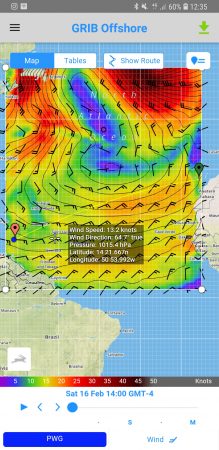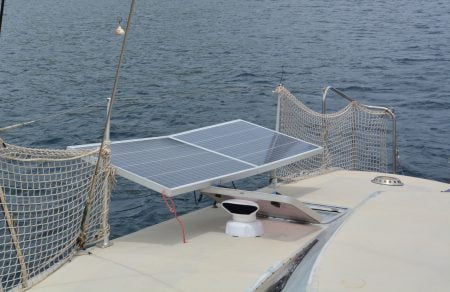“Humpback” was built in 1994 in Germany by Birkhard Bader for a gentleman named Jens Kerner who sailed her to the Caribbean and South America over the next three years. We think he then ran out of money and sold most of the parts off the boat. In 1997 Steve Woodward bought her as a bare hull – he renovated her extensively and sailed her for the next twenty years, mostly in the North Sea, before we became the owners. Soon after we moved aboard, Charlotte wrote a post about why we were looking for a cat and what it was about this boat that encouraged us to pick her – see here for more on that.
Humpback is based on David Kelsall’s Tonga 40 design, varied at the time of manufacture to add an additional 4’ or so of beam and an enclosed bridge-deck saloon. She’s lightly built – foam cored almost throughout (epoxy foam below the waterline, a much lighter foam above and for the interior bulkheads). The exceptions are the bottom of the keels, the bow, and the corners of the stern, each of which are solid fiberglass, and underneath a few of the most heavily loaded fittings where ply or fiberglass has been used to replace the core. Total weight in the region of 6 tonnes.

Last year while we were in Arrecife she was given a fresh coat of paint – Jotun Xtreme Gloss on the topsides, superstructure and on the slides (yes, slides); Interdeck deck paint; Coppercoat antifouling below the waterline. One day we’ll get around to finishing the edges of the deck paint, too…
Rig and sails
The rig is relatively small compared to most cruising catamarans. Around 35 square meters for the main, and the same again for the genoa. With a seven meter beam and only six tonnes of weight to push along, that gives us easy sail handing, a lot of stability and more than enough speed.
The genoa is on a roller furler, with the furling line and two jib sheet winches mounted centrally on the coachroof, a step away from the wheel. The jib sheets come back via one of two tracks – one right at the edge of the boat for when the wind is aft of the beam, one on the coachroof for windward work – along with a block adjacent to the mast used only when close-hauled.
The main is fully-battened and slab-reefed. As we have it set up currently it is raised, reefed and lowered at the mast. There are twin mainsheets, on two of four U-bolts over a span of about 4m, which give a lot of options for sail control. We also have a spinnaker, but on long downwind passages we set up twin headsails on the roller furler so the spinnaker doesn’t get used much.
dav
Full sails with wind on the beam give us 5 knots of boat speed in 8 knots of wind, and a 10 knot plus boat speed in 20 knots of wind if we have not put a precautionary reef in by then. Our fastest sustained sailing has been at 12 knots or so on a flat sea in the lee of Dominica. For long passages, on the other hand, we plan and average somewhere between 5 and 6 knots, which gives you an idea of how conservative we tend to be with our sail plan!
Engines
We have two Nanni 3.21 diesel engines driving Autostream feathering propellers through saildrives. We don’t tend to use the engines a lot but one engine gives a comfortable 5 knots at 2800 or so rpm (which seems to be very fuel efficient). Both engines can get the boat up to 8 knots or so or punch into any tide and headwinds we have encountered so far when entering harbour. The feathering propellers are awesome. You can feel the acceleration when you slide the gear lever into reverse while under sail, and the boat speed picks up by around half a knot.
For anyone who has never sailed a catamaran before, having an independent engine on each hull means we can spin in one spot, and makes short-handed mooring in marinas plausible/comfortable for us (even with a baby in the wrap). And means that if one engine breaks halfway across an ocean, you don’t need to fix it at sea.
Steering

The rudders are plywood skinned with fiberglass, hung on solid stainless-steel shafts. These need to be substantial as we can and do beach the boat using them and the keels. Gently, of course.
Steering is via a hydraulic pump on the back of the wheel, feeding a ram at each rudder. Until a boatyard screwed up the replacement of the port rudder’s top bearing, this meant steering was finger-light in all conditions. It is still fairly-light apart from when moving past 8 degrees of starboard helm in a following sea, and we’ll fix the rudder bearing in due course. We have a wheel pilot which has been relatively reliable; but are adding a Hydrovane wind vane partly for additional redundancy. The hydrovane would both give automated steering and an alternative emergency steering system with its auxiliary ridder/tiller combination.
Electronics and navigation
Our boat instruments are currently Raymarine ST60+ gauges for wind, depth, speed etc fed by the appropriate transducers. These are visible from most of the cockpit, but most convenient to view when at or near the wheel. We have also set up a tablet PC which can read the NMEA data via wifi, so we can keep an eye on the instrument readouts from inside. This isn’t often needed as we have found that we can feel the wind shifts. But it is there, and only takes a second to turn on, so often adorns the dinner table on longer passages.
Navigation is on a Standard Horizon CP50 chartplotter using C-Map charts. We are on our third megawide chart chip. AIS information comes to us through a Digital Yacht transponder – this gives us the course and speed (along with other information) of other vessels within VHF range (about 12 miles on average) and displays them on the chartplotter. It also means they can see us if they receive AIS. There’s also a radar, but don’t use it in normal conditions.
We use a laptop to plan routes on OpenCPN in advance, before copying any waypoints into the chartploter manually. The user C-card isn’t compatible with anything more recent than windows 98 – I think I’ll pick up an old laptop at some point. I have longer term plans to replace all of this with open source components, but for now that’s what we have!
Communications
Humpback came to us already fitted with two VHFs – one in each hull, each with a handset-plug in the cockpit, and their own GPS receiver and aerial, one on a radar pole at the stern, the other at the top of the mast. We are mulling over adding an SSB, too – we have a transceiver which we picked up second-hand at low-cost, but would have to add an antenna, tuner, and probably modem to get much use of out it. Not a priority at present.

To get weather information while on passage across the Atlantic we used an Iridium Go combined with a subscription to PredictWind, and it was fantastic. We only use the Iridium when sailing long distances, as the subscription is far from cheap (US$140 per month for unlimited data), so we cancelled it recently. Most places we have been so far have mobile phone signal for internet, and forecasts are mostly reliable for 2-3 days so on shorter passages we just go without.
We both still have mobile phone contracts based in the UK, mostly because of inertia. But given EU roaming regulations, we have also taken advantage of their data in places like the Canary Islands and Guadeloupe. We will probably cancel them at some point soon. We have found that the easiest thing to do when those SIM cards don’t give cheap data is just to buy a local SIM card and plug it into one of our phones.
Electrical, water, domestics:
Our main power store is a 300ah 12v lithium ion bank which we put together out of Winston Cells with a soldered-on BMS, along with a small 72ah AGM battery as an emergency backup, and 2x40ah lithium ion batteries located next to each engine and used exclusively as engine-starters. The main battery bank, as well as supplying the 12v domestics also feeds a 2kw inverter which can run a microwave OR (not and) kettle. Other “home” comforts include small fridge, electric hot water (not at anchor, except on the sunniest of days), an all-in-one PC, and a car stereo that feeds speakers in the saloon and cockpit.
An Aquatec DD500 watermaker supplies all of our water, stored in two 150 litre keel tanks and a jerry can for drinking water. It requires about 50 amps to run and delivers 60 litres per hour of fresh water. It’s on a well-fixed shelf between two bulkheads, sitting atop vibration isolating rubber pads. The noise is virtually imperceptible from the saloon or port hull, which given the pump operates at 60psi is awesome!

85% of our electricity comes from our solar panels. We have two 100W panels on each side of the boat, which can be tilted through a pretty wide range of angles using some home-made tilting mounts. Over the dinghy davits we have 4x80W flexible panels – they are too low to be fully effective but still give a decent output through the middle of the day. We also have an aerogen wind turbine which gives a useful amount of power when the wind is fairly consistent. And when all else fails, we have to run the port engine which has a charge-booster attached to it that maintains a decent alternator output (around 50A).



